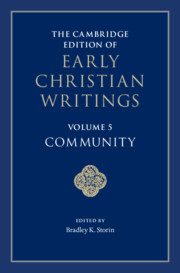Book contents
- The cambridge edition of EARLY CHRISTIAN WRITINGS
- The cambridge edition of EARLY CHRISTIAN WRITINGS
- the cambridge edition of EARLY CHRISTIAN WRITINGS
- Copyright page
- Dedication
- Contents
- Notes on Contributors
- Note on the Texts and Translations
- Preface
- Series Introduction
- Introduction
- Part I Entering the Community
- Part II Forming and Overseeing the Community
- Part III Imagining the Community
- 16 Tertullian of Carthage, On Repentance and On Modesty 1–4, 21–22
- 17 Cyprian of Carthage, On the Oneness of the Catholic Church (Second Edition)
- 18 Augustine of Hippo, Letter 87 to Emeritus of Caesarea
- 19 Augustine of Hippo, Sermons 227–229
- 20 Pseudo-Dionysius, On the Ecclesiastical Hierarchy 1, 5–7
- Part IV Policing the Community
- Suggestions for Further Reading
- Scriptural Index
18 - Augustine of Hippo, Letter 87 to Emeritus of Caesarea
from Part III - Imagining the Community
Published online by Cambridge University Press: 19 May 2025
- The cambridge edition of EARLY CHRISTIAN WRITINGS
- The cambridge edition of EARLY CHRISTIAN WRITINGS
- the cambridge edition of EARLY CHRISTIAN WRITINGS
- Copyright page
- Dedication
- Contents
- Notes on Contributors
- Note on the Texts and Translations
- Preface
- Series Introduction
- Introduction
- Part I Entering the Community
- Part II Forming and Overseeing the Community
- Part III Imagining the Community
- 16 Tertullian of Carthage, On Repentance and On Modesty 1–4, 21–22
- 17 Cyprian of Carthage, On the Oneness of the Catholic Church (Second Edition)
- 18 Augustine of Hippo, Letter 87 to Emeritus of Caesarea
- 19 Augustine of Hippo, Sermons 227–229
- 20 Pseudo-Dionysius, On the Ecclesiastical Hierarchy 1, 5–7
- Part IV Policing the Community
- Suggestions for Further Reading
- Scriptural Index
Summary
Augustine was plunged into the Donatist controversy upon becoming bishop of Hippo in 395. In the wake of the Diocletianic persecutions in the early fourth century, the Donatists had split from the group whom Augustine called and considered “catholics” (i.e., “worldwide Christians”), creating a schism in the North African church that lasted for well over a century. The very nature of the church was in dispute: Donatists believed that the church must retain its purity and holiness, separating itself from sinners, whereas catholics maintained that the church could tolerate the presence of sinners as long as consent was not given to their sin. Donatists believed that catholics were implicated in the sin of those who lapsed in the Diocletianic persecutions by handing over the scriptures to imperial authorities; they believed that only by retaining its purity in this way could the church guard against catholic contagion. Furthermore, they regarded any sacrament administered by a cleric in a state of sin as invalid, and accordingly former catholics entering their communion had to be baptized (for the first time, in their view).
Information
- Type
- Chapter
- Information
- The Cambridge Edition of Early Christian Writings , pp. 343 - 354Publisher: Cambridge University PressPrint publication year: 2025
